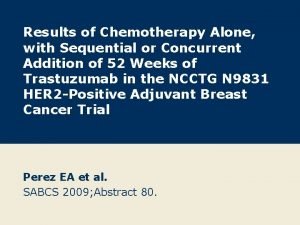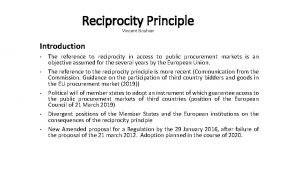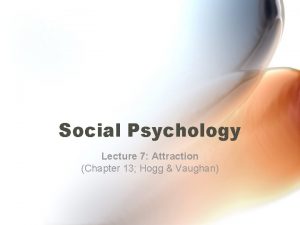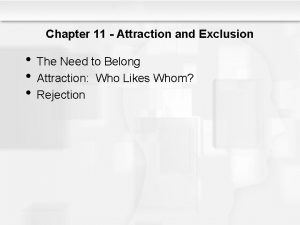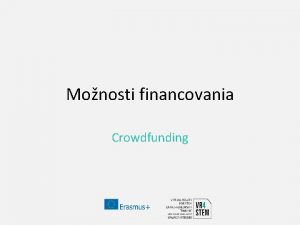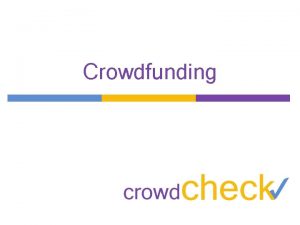Crowdfunding Chemotherapy Worthiness Reciprocity and Community on Go















- Slides: 15

Crowdfunding Chemotherapy: Worthiness, Reciprocity, and Community on Go. Fund. Me Presented by Sarah Paust

Crowdfunding is the practice of raising small amounts of money from many donors (the “crowd”) online.

Research Questions 1. How do successful medical crowdfunding campaigns mobilize discourses of worth and community to imbue charitable giving with notions of reciprocity? 2. How do the news media participate in such discursive processes? 3. To what extent do campaigners and journalists frame these narratives as political ones?

Methods ● Discourse analysis of ten campaigns. ○ ○ ○ Selected from the “Trending” section of Go. Fund. Me in September 2019. Analyzed campaign descriptions, updates, videos uploaded by organizers, and ten most recent comments left by donors. Developed coding frame (concepts and clusters of terms) for campaign descriptions and updates. ■ Urgency, need, worth, gratitude, spirituality, reciprocity. ● Close reading of 130 news articles. ○ ○ ○ Selected from Pro. Quest US Newsstream in September 2019. ■ 82 commentaries on the phenomenon of medical crowdfunding (i. e. op-eds). ■ 48 articles covering local campaigns (i. e. human interest stories). Published between January 2011 and September 2019. Tone, structural characteristics, emergent themes, political commentary, and ethical concerns.

Major Findings

Narrativity How do Go. Fund. Me campaigns work? ● Temporality: Updates are always posted in reverse chronological order, creating a sense of urgency. ● Gendered: Almost all campaigns were organized by women. ● Affectual: Campaign narratives sought to elicit an emotional response in the reader through the use of reflective anecdotes.

Narrativity How are worthy recipients created through campaign narratives? ● Hardworking: “We believe the laborer is worthy of their wage and are not asking for anything for free. ” ● Optimistic: “There is inspiration around every corner. ” ● Religious: “Faith moves and acts. ”

Reciprocity What do beneficiaries offer donors? ● Gratitude: “Thank you! We call you loved and blessed!” ● Updates: Personal updates and photos cultivate intimacy and forge an ongoing relationship between donors and recipients. ● Biosociality: Commenters often wrote that they donated in memory of a loved one with the same illness, or to “stand in solidarity. ”

“We too celebrate everyday our loving Father & Husband… who fought the AML battle to the very end. ” Comment left by donor to “Sladek Strong, ” which demonstrates the importance of biosociality to fundraising success.

Reciprocity How can reciprocity be challenged or leveraged? ● Donation can also be an investment strategy: Commenters occasionally linked their personal campaign webpages, Pay. Pal accounts, or Venmo usernames. “This campaign is almost funded. Now please help me…”

Media Coverage How do journalists represent medical crowdfunding? ● Worthiness: Journalists tended to reproduce images of beneficiaries as hardworking, valued community members. ● Risks: Donors are vulnerable to scams, and recipients are vulnerable to suspect, experimental, or “alternative” treatments.

Media Coverage How is the media coverage complicated? ● Ethical divide: Is medical crowdfunding democratizing Americans’ access to healthcare, or is it a symptom of a broken healthcare system? ● Change over time: Since 2015, there has been an uptick in critiques of medical crowdfunding in national newspapers.

Conclusions

“So what? ” Why should we care about medical crowdfunding? 1. Medical crowdfunding narratives represent a form of gendered, affective labor. 2. This affective labor relies on the creation of reciprocity between donors and recipients, as well as biosocial communities. 3. The precariousness of health funding in the United States is reflected in the individualism of campaign and media narratives.

Select References ● ● ● Berliner, Lauren S. , and Nora J. Kenworthy. 2017. “Producing a worthy illness: Personal crowdfunding amidst financial crisis. ” Social Science & Medicine 187: 233 -242. Frank, Arthur W. 1993. “The Rhetoric of Self-Change: Illness Experience as Narrative. ” Sociological Quarterly 34 (1): 39 -52. Hanson, John H. 2015. “The Anthropology of Giving: Toward A Cultural Logic of Charity. ” Journal of Cultural Economy 8 (4): 501 -520. Murdoch, Blake, Alessandro R. Marcon, Daniel Downie, and Timothy Caulfield. 2019. “Media portrayal of illness-related medical crowdfunding: A content analysis of newspaper articles in the United States and Canada. ” PLo. S ONE 14 (4): e 0215805. Page, Ruth. 2011. “Blogging on the Body: Gender and Narrative. ” In New Narratives: Stories and Storytelling in the Digital Age , edited by Ruth Page and Bronwen Thomas. Lincoln: University of Nebraska Press, 220 -238. Rabinow, Paul. 1996. “Artificiality and Enlightenment: From Sociobiology to Biosociality. ” In Essays on the Anthropology of Reason , edited by Paul Rabinow. Princeton: Princeton University Press, 91 -111.
 Crowdfunding cvm
Crowdfunding cvm Equity crowdfunding hong kong
Equity crowdfunding hong kong Mdx crowdfund
Mdx crowdfund Bsa calculation formula for chemotherapy
Bsa calculation formula for chemotherapy Icd 9 code for oral thrush
Icd 9 code for oral thrush Principles of chemotherapy
Principles of chemotherapy General principles of chemotherapy
General principles of chemotherapy Chemotherapy
Chemotherapy Chemotherapy
Chemotherapy Team around the family
Team around the family 4ac 4t chemotherapy
4ac 4t chemotherapy Vincent bouhier
Vincent bouhier Reciprocity program
Reciprocity program Reciprocity of attraction
Reciprocity of attraction Moreland and beach (1992)
Moreland and beach (1992) Liking begets liking
Liking begets liking







